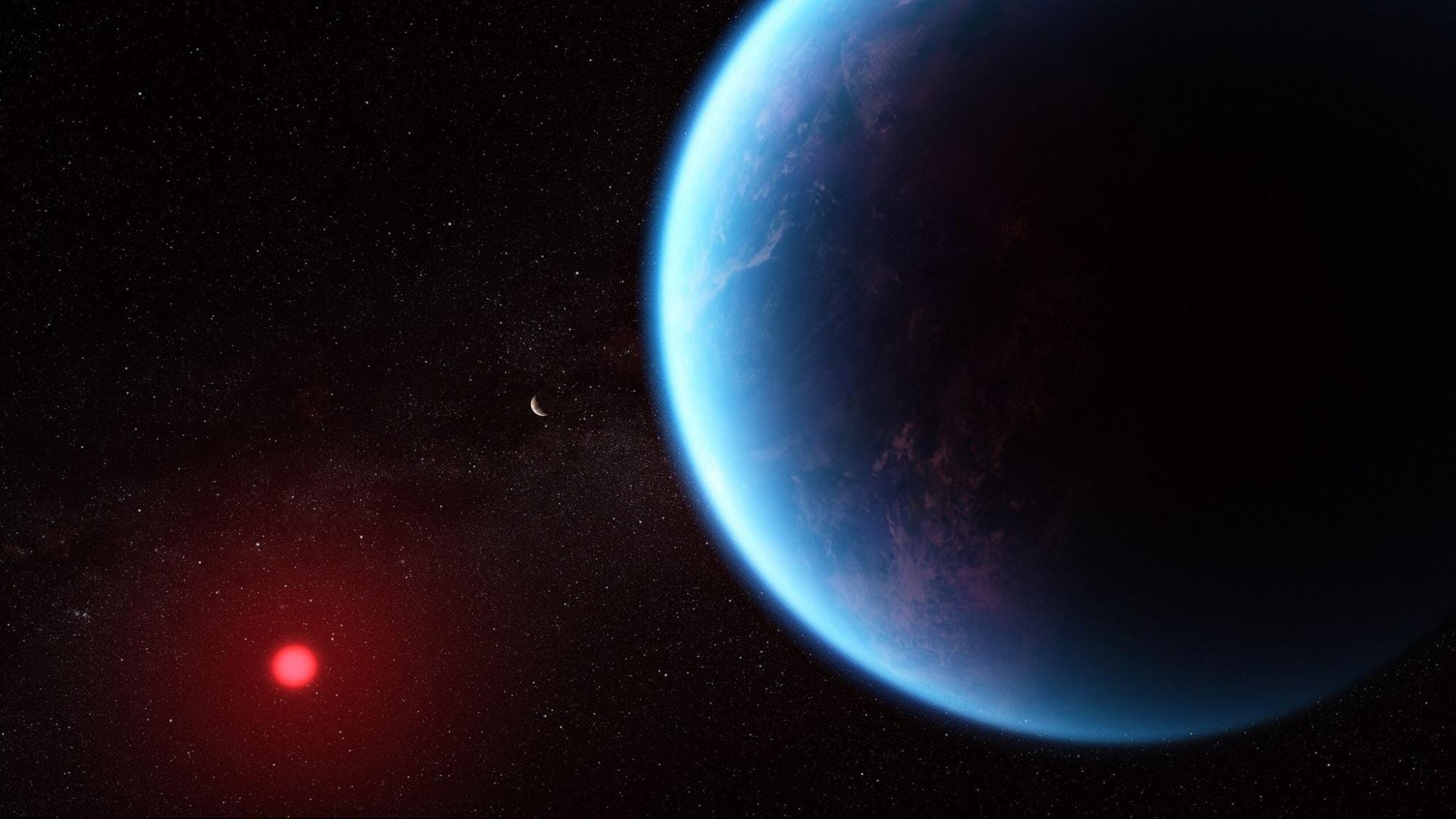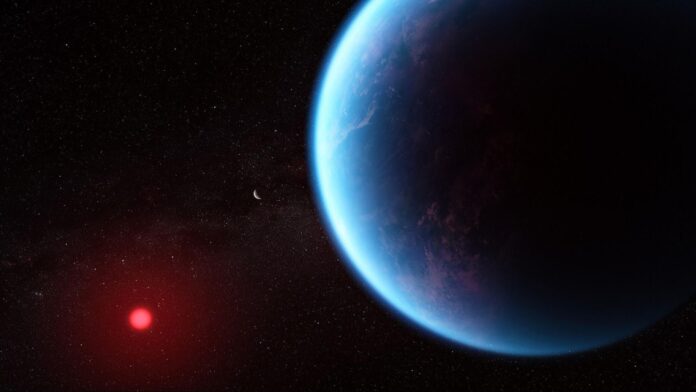
Welcome back to the Abstract!
It was a good week for the Fox Mulders among us. We want to believe, and a new study has given us some empirical grist along those lines. I shall say no more, and let the giant planet K2-18b speak for itself.
Next, remember the time that Earth partied so hard that the Northern Lights showed up in the Sahara and humans had to invent sunscreen? Hahaha…our planet just DGAF sometimes. Then, the Perseus cluster thought it could get away with eating a subcluster, but we have the EVIDENCE. Last, dino-walk with me.
“It’s Never Aliens”…Oh Shoot, This Time It Actually Might Be Aliens
Scientists have reported some of the most compelling evidence for extraterrestrial life ever identified, teasing what would be the most anticipated scientific breakthrough in history.
The possibly life-bearing world in question is K2-18b, a giant planet about eight or nine times as massive as Earth located about 124 light years away. It belongs to a tantalizing class of “Hycean” planets that may host global liquid water oceans under thick hydrogen-rich atmospheres.
K2-18b has attracted a lot of interest in recent years because water vapor, carbon dioxide, and methane have been detected in its skies at concentrations that hint at the presence of life. That said, planets can bake up those compounds in all kinds of ways that don’t involve beasties. That’s why scientists decided to put this world into the sights of the James Webb Space Telescope, the most sensitive observatory ever, to see if they could find anything more concrete.
Webb delivered by confirming the presence of dimethyl disulfide (DMDS) and dimethyl sulfide (DMS)—compounds that are concocted by microbes here on Earth— in the skies of K2-18b. It’s not yet an alien slam dunk, because there are a few abiotic processes that also can make this stuff. But there are simply fewer ways to explain their sustained presence in a planet’s skies without invoking biological processes, compared to water, carbon dioxide, or methane.
“We present a mid-infrared transmission spectrum of K2-18b with JWST, the first for a habitable-zone exoplanet,” said researchers led by Nikku Madhusudhan of the University of Cambridge. “The spectrum shows multiple spectral features…that are best explained by a combination of DMDS and DMS in the atmosphere, both molecules uniquely produced by life on Earth and predicted as promising biosignatures in habitable exoplanets.”
DMDS and DMS are largely produced by marine microbes, such as phytoplankton. It’s alluring to envision a massive ocean world blushing with colorful microbial blooms as it orbits its red dwarf star, just 124 light years away (an immense distance for humans, but just down the street on galactic scales).
Still, the team emphasized that abiotic sources of these compounds should be rigorously explored, and noted that they can be found on barren comets in our own solar system. It’s possible that similar comets in the K2-18 system may have recently crashed into this massive world, producing some transient signatures captured by Webb, though it would be a bit of a coincidence. Future observations may distinguish the likely sources of the compounds, and perhaps find even more signs of life (or signs of not-life).
Humans have often imagined our “first contact” moment with aliens as irrefutable. We receive an unambiguously artificial transmission. An ancient alien artifact is unearthed from a nearby planet. Aliens straight-up show up on Earth to invade or enlighten us.
But it seems much more likely that this vexing mystery—is life on Earth a fluke or the norm?—will be constrained through a slow and grinding probabilistic framework. We may never conclusively determine if K2-18b hosts life; the best we might get is a gradient of more to less probable. As scientists accumulate reams of data from other planets, we will get a lot more smoke signals but may never find an actual smoking gun.
“Overall, our findings present an important step forward in the search for signatures of life on exoplanets,” according to the study. “However, robustly establishing both the veracity of the present findings and their possible association with life on K2-18 b needs a dedicated community effort in multiple directions—observational, theoretical, and experimental.”
“The central question now is whether we are prepared to identify the signatures of life on such worlds,” the team concluded. “The opportunity is at our doorstep.”
A Tale of Auroral Escapes and Neanderthal Capes
Mukhopadhyay, Agnit et al. “Wandering of the auroral oval 41,000 years ago.” Science Advances.
Even Mother Earth, the one world that we know hosts life, can be a bit of a chaotic parent at times. For instance, our planet went on a little bender about 41,000 years ago, called the Laschamps geomagnetic excursion, in which it temporarily lost its magnetic bearings for about 2,000 years.
As the magnetic poles shifted from the geographic poles, Earth’s magnetic shield was reduced to 10 percent of its strength, exposing everything on its surface to a flood of cosmic radiation. The excursion also caused auroras to become unmoored from the poles, thereby drifting to lower latitudes and causing the Northern Lights to dance over the Sahara.
This bizarre episode may have inspired our human ancestors to invent sunscreen out of ochre and develop tailored clothing to avoid radiation exposure, according to a new study. The work also suggests that Neanderthals may have failed to adapt to the changes, perhaps contributing to their extinction around the same time as the Laschamps excursion.
Ochre shows “increased frequency in archaeological sites dating to the peri-Laschamps” which “could be due in part to its use as a sunscreen” by anatomically modern humans (AMH), said researchers led by Agnit Mukhopadhyay of the University of Michigan.
“Although both Neanderthals and contemporary AMH produced technologies associated with clothing manufacture, only AMH appear to have produced technologies consistent with the manufacture of tailored clothing; Neanderthals are assumed to have produced only relatively simple, draped clothing (e.g., capes)…Neanderthals’ decline was almost certainly multifactorial, but it is possible that topical sunscreens and tailored clothing provided AMH essential photoprotection and access to resources in places and at times they would otherwise have been inaccessible” which may have been “a competitive advantage.”
First of all, we need to bring back Neanderthal capes. They have been out of fashion for 41,000 years, so a revival is frankly overdue. Second, it would be wild if humans outlived Neanderthals in part because we wore sunscreen. Has there ever been a better advertisement for Big SPF?
But that is only the skin-deep part of this cool and expansive study, which also speculated that the excursion may have inspired new forms of art and music. “Others have noted co-occurrence of the Laschamps with the earliest known representational cave art—which depicts animals, anthropomorphs, and other figures or scenes, as opposed to abstract marks or designs—including images of animals,” the team said. “To this, we add that the Laschamps event coincides with early examples of portable art and musical instruments.”
The researchers also warned that if the same event happened today, we would be up a magnetic creek without a paddle. “Considering the probable impact of the Laschamps excursion on early humans and their way of life, a similar event today would likely have dire consequences for modern humans,” the team noted. “The ramifications of a Laschamps-like magnetospheric configuration and auroral oval would reverberate across all facets of modern communication, satellite infrastructure, and intercontinental travel.”
I know, I know, you really needed one more thing to worry about. You had so many wonderful worries, but to fill out your collection, I present you with this one about Earth’s magnetic field shutting down for a millennium or two. No geomagnetic excursions are imminent, according to the study, but it will eventually happen again, so something to be aware of, I guess.
In the meantime, honor your ancestors by wearing sunscreen!
SOLVED: The Case of the Missing Subcluster Halo
Hyeonghan, Kim et al. “Direct evidence of a major merger in the Perseus cluster.” Nature Astronomy.
We’ll now zoom out from planetary scales all the way up to the mind-detonating expanse of the Perseus Cluster, one of the most massive objects in the known universe. This thing is just a lot of galaxies—at least 1,000, probably a lot more—that are all gravitationally jostling around each other some 240 million light years from Earth.
Based on its dynamics, it looks like the cluster ate a smaller “subcluster” in the past as part of a “major merger.” But until now, scientists have not been able to track down the companion that was absorbed into the Perseus whole, which is a missing piece that has really been bugging them.
“Although the Perseus cluster has often been regarded as an archetypical relaxed galaxy cluster, several lines of evidence …suggest that the cluster might have experienced a major merger,” said researchers led by Kim HyeongHan of Yonsei University. (I also identify as an “archetypical relaxed” entity).
“However, the absence of a clear merging companion identified so far hampers our understanding of the evolutionary track of the Perseus cluster consistent with these observational features,” the team said.
We simply must not be hampered in our understanding of the evolutionary track of the Perseus cluster. To that end, the team used weak lensing, an observational technique based on gravitational distortions, to locate the swallowed companion.
Well, everyone: We got ‘em. “Here, through careful weak-lensing analysis, we successfully identified the missing subcluster halo,” which is located about 430 kiloparsecs (1.4 million light years) west of the Perseus main cluster core,” the team said. “This discovery resolves the long-standing puzzle of Perseus’s dynamical state.”
And to think, Perseus would have gotten away with it, too, if it weren’t for those meddling weak lenses. Another cosmic cold case closed.
Slap a “Coexist” Bumper Sticker on These Armoured Dinosaurs
We’ll close by walking in the footsteps of an ankylosaurus, the dinosaurian equivalent of a tank. Some 100 million years ago, these giant armored dinosaurs left footprints in what is now the Canadian Rockies, which paleontologists have identified as the only known ankylosaurid ankylosaur tracks in the world.
The name “ankylosaurid ankylosaur” may seem a bit redundant, but it exists because there is such a thing as—you guessed it—a non-ankylosaurid ankylosaur (also known as a nodosaurid). These two major ankylosaur lineages differed in many ways, including in the number of digits on their hind feet (ankylosaurids had three, nodosaurids had four).
Paleontologists had previously identified the footprints of Tetrapodosaurus borealis, the four-toed variety, in mid-Cretaceous trackways near the town of Tumbler Ridge, in British Columbia, and at Dunvegan Bridge, Alberta. Now, a team has pinpointed the tell-tale “tridactyl” prints of an ankylosaurid ankylosaur representing a new species, named Ruopodosaurus clava.
“This new taxon is currently known exclusively from the Cenomanian of northeastern British Columbia and northwestern Alberta, and provides confirmation that ankylosaurid ankylosaurs were present in North America prior to the Campanian–Maastrichtian,” said researchers led by Victoria Arbour of the Royal BC Museum. “Ruopodosaurus clava is found in the same localities and deposits as Tetrapodosaurus borealis, indicating that both ankylosaurid and non-ankylosaurid ankylosaurs co-existed in the mid Cretaceous of the Peace Region.”
Co-existence between giant armoured dinosaurs in a place now named the Peace Region? The reality simulation writers did well with this one.
Thanks for reading! See you next week.




